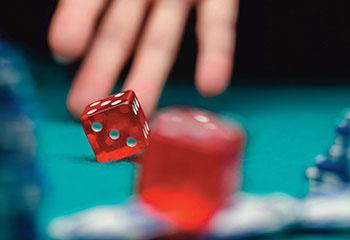“POPPING” YOUR WAY TO A WIN
An advanced strategy for cashing in at craps
By Frank Scoblete
Editor’s Note: The following is adapted from Frank Scoblete’s book Cutting Edge Craps: Advanced Strategies for Serious Players!)
 Many industry writers and other critics of dice control constantly throw out this challenge: “If the dice have to hit the back wall, there is no way the game can be changed from a random one to a controlled one. The pyramids make every throw a random result. Dice control can’t possibly work if you hit the back wall.”
Many industry writers and other critics of dice control constantly throw out this challenge: “If the dice have to hit the back wall, there is no way the game can be changed from a random one to a controlled one. The pyramids make every throw a random result. Dice control can’t possibly work if you hit the back wall.”
Many casino pit people, box people, and dealers also subscribe to the above argument. Yet, surprisingly, they are often the very same individuals who seem to sweat out good shooters’ rolls on their craps tables. This irony is not lost on me. Indeed many casino industry “thinkers” believe that Golden Touch dice control classes try to teach students to miss the back wall in order to eliminate the randomness of the game. Of course, this is not true. You can hit the back wall and still win consistently.
The foam rubber pyramids were assuredly put in to guarantee that the game of craps is indeed random. Dice bouncing off those pyramids get scattered this way and that. The casinos need a random craps game to win money from players. Random is good for the casinos, but not for the players. However, the game of craps can be beaten. For competent dice controllers, the pyramids are merely an annoyance, not a hindrance to exercising dice control. Hitting the back wall of pyramids is not the same as hitting a flat back wall except when it is exactly that. Yes, sometimes those pyramids are exactly the same as a flat wall!
Now follow me closely as I explain this phenomenon. I’m about to share with you something you have never read before. No critics, craps players, casino executives, industry thinkers, or students (except for those who belong to Golden Touch) know what you are about to learn. On back walls where the pyramids are small or medium distances from each other, and/or where larger dice are used, the dice will occasionally hit the pyramids in a manner as if they were actually hitting a flat back wall.
Picture this in your mind. A single die bounces off the layout and hits two adjourning pyramids on their points. The right side of the die hits one pyramids point; the left side of the die hits the other pyramid’s point. That die comes straight back towards the layout as if the back wall were instead a flat wall. This is because a double-point hit is actually like hitting something that is flat. By striking the pyramids in this manner, that die will keep most of the non-randomness of the shooter’s throw. The other die might skew a bit, but it will be coupled with a die that has skewed little or not at all.


